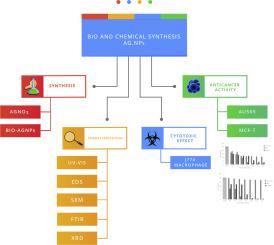Journal of Photochemistry and Photobiology B: Biology ( IF 3.9 ) Pub Date : 2020-05-20 , DOI: 10.1016/j.jphotobiol.2020.111902 Sahar Dinparvar 1 , Melahat Bagirova 1 , Adil M Allahverdiyev 1 , Emrah Sefik Abamor 1 , Tural Safarov 1 , Mehmet Aydogdu 1 , Didem Aktas 1

|
The present study reports the anticancer activities of Cuminum cyminum L. (Cumin) seed extract, chemically synthetized silver nanoparticles (AgNPs) and biosynthesized silver nanoparticles (Bio-AgNPs) from Cumin seeds on human breast adenocarcinoma cell line (MCF-7) and human breast adenocarcinoma metastatic cell line (AU565). The synthetized nanoparticles were characterized by dynamic light scattering (DLS), UV–visible spectroscopy (UV–Vis), X-ray diffraction (XRD), Fourier-transform infrared spectroscopy (FTIR) and Scanning electron microscopy (SEM). The cytotoxic and anticancer effects of AgNPs and Bio-AgNPs were determined by MTT assay. According to the cytotoxicity analysis, Bio-AgNPs appears to be less toxic against J774 macrophage cells than AgNPs since IC50 values were measured as 0.75 and 1.25 μg/ml for AgNPs and Bio-AgNPs, respectively. On the other hand, Bio-AgNPs demonstrated significant inhibitory effects on human breast cancer cells at non-toxic concentrations such as 0.25 and 0.5 μg/ml. However, at increased concentrations, the lethal effects of AgNPs on breast cancer cells were higher than Bio-AgNPs. When cytotoxic and anticancer characteristics of Cumin extract were investigated, it was established that it did not show any inhibitory effect on J774 cells, while killing the half of MCF-7 cells at investigated concentrations. Interestingly, Cumin extract gave rise to no inhibitory effects against AU565 cells. On the other hand, AgNPs and Bio-AgNPs exhibited considerable anticancer activities on both cell lines. The inhibition percentages of AgNPs on MCF-7 and AU565 cell lines were respectively evaluated as 95% and 97% at the highest concentrations applied (12.5 μg/ml). Similarly, we determined that 87.5% and 96% of MCF-7 and AU565 cells were respectively inhibited when they were exposed to the highest concentrations of Bio-AgNPs. Considering relatively toxic-free features of Bio-AgNPs prepared from Cuminum cyminum L. seed extracts, it can be thought that this formulation will be a pioneer in development of nanotechnology-based new anticancer drug for the treatment of breast cancer in near future.
中文翻译:

一种基于纳米技术的乳腺癌新治疗方法:使用小茴香种子提取物生物合成银纳米颗粒。
本研究报告了小茴香种子提取物,化学合成的银纳米颗粒(AgNPs)和生物合成的银纳米颗粒(Bio-AgNPs)对人乳腺癌细胞系(MCF-7)和人的抗癌活性。乳腺癌转移细胞系(AU565)。合成的纳米粒子的特征在于动态光散射(DLS),紫外可见光谱(UV-Vis),X射线衍射(XRD),傅里叶变换红外光谱(FTIR)和扫描电子显微镜(SEM)。通过MTT法测定AgNPs和Bio-AgNPs的细胞毒性和抗癌作用。根据细胞毒性分析,自IC 50以来,Bio-AgNPs对J774巨噬细胞的毒性似乎不如AgNPs。AgNPs和Bio-AgNPs的测量值分别为0.75和1.25μg/ ml。另一方面,Bio-AgNPs在无毒浓度(例如0.25和0.5μg/ ml)下对人乳腺癌细胞表现出显着的抑制作用。然而,在浓度增加的情况下,AgNPs对乳腺癌细胞的致死作用要高于Bio-AgNPs。当研究孜然提取物的细胞毒性和抗癌特性时,可以确定它对J774细胞没有任何抑制作用,而在所研究的浓度下杀死了一半的MCF-7细胞。有趣的是,孜然提取物对AU565细胞没有抑制作用。另一方面,AgNP和Bio-AgNP在两种细胞系中均显示出相当大的抗癌活性。在施加的最高浓度(12.5μg/ ml)下,AgNPs对MCF-7和AU565细胞系的抑制百分比分别为95%和97%。同样,我们确定当暴露于最高浓度的Bio-AgNPs时,分别抑制了87.5%和96%的MCF-7和AU565细胞。考虑到制备的生物AgNP的相对无毒特性Cuminum cyminum L.种子提取物,可以认为该制剂将在不久的将来成为开发基于纳米技术的新型抗癌药物以治疗乳腺癌的先驱。









































 京公网安备 11010802027423号
京公网安备 11010802027423号